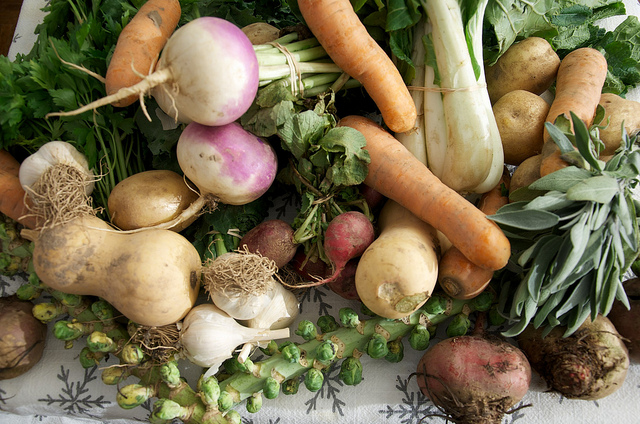Remember in that movie Interstellar when they had to find a new planet because Earth became barren?
Considering the science of genetically engineered food is a few steps ahead of billion-person space travel, our hope for survival as food becomes scarcer due to overpopulation and climate change rests on mass-producing food to godlike degrees.
Drought, storms and unprecedented heat have already affected crop yields (1). Within forty years, experts predict a worldwide population of nine billion, which would increase food demand between 70 and 100 percent (3).
Food industry giants like Monsanto, Bayer and ConAgra assert that the only way to match Earth’s progressively extreme conditions and our ballooning population is by genetically modifying what we eat.
This enticing idea is, so far, unfounded: USDA ERS reports show that, since the commercialization of genetically modified (“GM”) crops in the mid-1990s, genetic engineering has not significantly increased food production, if at all (4).
But causation is ambiguous; despite public fear of GMO pandemic, consumer GM crops are limited to: papaya, squash, sugar beets and the U.S.’s corn, soy, canola and cotton crop. Small sample size and short trial time should prevent generalizations about GMOs’ incapacity to alleviate future starvation, especially when we see no other options.
Moreover, scientists engineered the first generation of GM crops to be insect-resistant and herbicide-tolerant, not drought-tolerant or disease resistant—adaptations harder to manufacture. Future crops impervious to climate change and disease could bolster production.
Cornell plant breeding and genetics professor Margaret Smith advocates a second generation of GM crops: “It would be a mistake to rule out this tool because the first products didn’t address the big issues.” Considering agricultural production pressures and the billions of lives at stake, Sainsbury Laboratory plant disease expert Jonathan Jones thinks it would be not just a mistake but “perverse” (1).
While Monsanto races to engineer wheat adaptable to unpredictable climates and researchers make potatoes resistant to blight (the fungus responsible for the Irish potato famine), attempts by both scientists and lobbyists to put GM crops to market usually fail at the hand of the public.
Opponents of genetic engineering argue that inserting foreign genes into crops could adversely affect the environment or make food dangerous and/or allergenic. Yet, like the contention that GMOs fight world hunger, these claims are also scientifically unsubstantiated.
The MIT Technology Review found that “more than 15 years of experience with transgenic crops have revealed no health dangers, and neither have a series of scientific studies.”
Nor has the environment suffered. While ecological concerns range from super-weeds to pesticide-resistant insects, 15 years of GM crop cultivation has yet to produce either—particularly notable given the rapid evolution of plants and insects.
In fact, a third-party study assessing environmental impacts of the first 17 years of biotech crops revealed that genetic engineering reduced environmental footprint associated with pesticide use by 18.7 percent worldwide. And it has cut greenhouse gas emissions by an equivalent of taking 11.9 million cars off the road (5).
The GMO-based decrease in food chemicals aids the environment as well as our health. Bt—a bacteria gene that repels insects when inserted into plant DNA—has been used by organic farmers as a topical natural pesticide alternative for decades. Widely accessible GM crops could cause less chemical-ridden diets globally.
Finally, GM crops allow farmers to produce more food with less land—a significant advantage as Earth is, literally, eaten up. The challenge, writes The Guardian, “is to get more from existing land in a sustainable way or face the alternative, which is that people will go unfed, or we’ll have to bring more wilderness land into cultivation.”
But again: short trial period and small sample size precludes us from weighing these findings too heavily. While GMOs have thus far not proved damaging to our health or environment, the unforeseen carries massive risks.
For example, as Monsanto’s early experiments with GM wheat revealed, seeds can transfer to neighboring fields, making a future problem inextinguishable. Ohio State University plant ecologist Allison Snow says: “We’ve let the cat out of the bag before we have real data, and there’s no calling it back” (2).
Only one percent of USDA biotech research money goes toward risk assessment. Yet the whole GM operation is essentially an experiment.
The Non-GMO Project—the national certifier of non-GMO consumer products—states, “Americans are taking matters into their own hands and choosing to opt out of the GMO experiment.”
Indeed, as citizens afforded the opportunity to shop anywhere and pay the price of certification, we can choose not to risk eating GMOs. But disadvantaged populations and future generations may not have that privilege, making this experiment all the more critical to carry out.
While we shouldn’t submit ourselves as guinea pigs to the biased corporations currently conducting much of the research on GMOs, we do need to back the bipartisan vetting of genetic engineering with votes, research grants and public demand of ongoing risk assessment. Instead of dismissing GMOs out of fear of change or science we don’t know, we need to endorse their exhaustive testing and monitor their impact excessively.
Like experimental cancer drugs, GMOs are questionably effective and pose considerable side effects. But their potential benefit demands we seriously consider their utility. GM crops could spare land, reduce carbon footprint, curtail chemicals in our food and atmosphere, and feed a soon-to-be extortionate population: they could save us.
But, as with cancer treatments, a lengthy and contained testing period is vital—a challenging reality given our imminent need.
If we wait too long to put research to action, we risk regressing into the land of “too late” posed by Interstellar. The alternative? Too hastily and hungrily exiting the testing phase, becoming zombies like in that movie I am Legend.
Notes:
1. Rotman, David. “Why We Will Need Genetically Modified Foods.” MIT Technology Review. 17 Dec. 2014. Web. 30 Dec. 2014.
2. Ackerman, Jennifer. “Altered Food, GMOs, Genetically Modified Food – National Geographic.” National Geographic. Web. 30 Dec. 2014.
3. “FAO – News Article: 2050: A Third More Mouths to Feed.” Food and Agriculture Organization of the United Nations. 23 Sept. 2009. Web. 30 Dec. 2014.
4. Livingston, Michael, Seth James Wechsler, and Jorge Fernandez-Cornejo. “Adoption of Genetically Engineered Crops by U.S. Farmers Has Increased Steadily for Over 15 Years.” United States Department of Agriculture Economic Research Service , 4 Mar. 2014. Web. 30 Dec. 2014.
5. “Pocket K No. 4: GM Crops and the Environment.” GM Crops and the Environment. International Service for the Acquisition of Agri-Biotech Applications, 1 Aug. 2013. Web. 30 Dec. 2014.
Love elephant and want to go steady?
Sign up for our (curated) daily and weekly newsletters!
Author: Caroline Beaton
Apprentice Editor: Hilda Carroll / Editor: Emily Bartran
Photo: Photo by Charles Smith via Flickr












Read 3 comments and reply